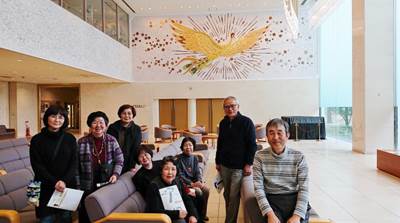Yu-Ai February issue 2019 — Joining the study tour to Kyoto Museum for World Peace, Ritsumeikan University
Yu-ai Friendship
Newsletter of the World Friendship Center, NPO
Joining the study tour to
Kyoto Museum for World Peace, Ritsumeikan University
Katsumi Takahashi
On a light rainy day at the end of January, we traveled to Kyoto to visit the Kyoto Museum for World Peace, Ritsumeikan University. There were eight of us in all: four WFC board members, four Hiroshima Pass-on-Project lecture participants. At Kyoto station, we were met by Ms. Yoshiko Tanigawa, a volunteer guide from the museum. She led us to a bus on which we headed for Ritsumeikan University at the foot of Mt. Kinugasa. According to her explanation, of its type as a university-established museum, it is unsurpassed in the world as regards its scale and exhibits. We were excited, looking forward to seeing all this.
At first we visited Suekawa Memorial hall, named after the honorary president Hiroshi Suekawa who was from Iwakuni. Mr. Suekawa’s relics exhibition was held there. There Ms. Rumi Hanagaki greeted us. She was exposed to the atomic bomb in Yokogawa at the age of five years old. Now she is a caretaker for the Kyoto atomic and hydrogen bomb survivors’ consultation group. After lunch at the restaurant in the hall and introducing ourselves, we heard Ms. Hanagaki’s testimony as a hibakusha. She said that the circumstances at the time of exposure to the blast, especially what she experienced while evacuating to Mitaki had returned to her years later as flashbacks.
Moving to the museum next door, the roses of Anne welcomed us at the entrance. Entering the building, there was a comfortable spacious lounge. On the east and west walls, two “Phoenix fire birds” reliefs by Osamu Tezuka representing the epidemic of past war to bright future were glowing lustrously, and we were met by the impressive enshrined Muchan Peace Statue. Ms. Tanigawa explained that Muchan was a girl with tuberculosis who had been kept quarantined alone in a shelter, and had starved to death without knowing that the war was over.
Then finally we went to the lower first floor to the main permanent display, “Staring at Peace”. The exhibition starts when you go down the stairs looking at the large Wadatsumi (God of the sea) statue along one side. The exhibits on this floor were divided into two themes: the “Fifteen years war” and “Modern wars”. For the “Fifteen years war”, there was a huge display of primary materials with easy to understand neutral explanations based on historical facts. I was deeply impressed. I was able to learn a lot of things which I hadn’t known.
This museum was established following deep reflection on the fact that Ritsumeikan had been a strongly militaristic school before the war. Everywhere I saw the strong intention to nurture the subject of creating peace.
Contents of the respective exhibitions were significant. The themes were: ① Military and soldiers (Characteristics of the imperial army), ② General public mobilization (War cooperation system), ③ Colonies and occupied territories (Anti-Japanese movement), ④ Air raids, the Battle of Okinawa, the Atomic bomb, ⑤ Efforts for peace (about the Japanese antiwar movement), and ⑥ Responsibility for war. Among the exhibits that remain strongly impressed in my memory are the heavy backpacks, up to 30kg, which the soldiers carried, an aerial photograph showing the plan to drop the atomic bomb on Kyoto, which had been among the first possible targets (a circle with a radius of 2.4 km from the Ume alley engine depot), and anti-Japanese slogans.
Then we went upstairs and looked around the “Peace Creation Exhibition Room”. Here, one area for reflecting on violence and peace was introduced, around the central theme of “Peace is not just the absence of conflict”. I became aware of the various issues that exist around us.
In the next room was an exhibition of works from art students who died in the war, kept in this Kyoto Hall section of the “Silent Hall” museum located in Ueda City, Nagano Prefecture. I faced the works of the art students who had lost their lives so young.
In this visit to the Kyoto Museum for World Peace, Ritsumeikan University, through the huge display of exhibits built on academic knowledge, I was able to gain some understanding of the stupidity of war and a realization that peace can be achieved through the proactive behavior of individuals. It was a very meaningful tour for our future peace activities.
Finally, I wish to express my appreciation to our guides, Ms. Tanigawa and Ms. Hanagaki, and to every member of the board of the World Friendship Center.

From left to right: Ms. Niki, Ms. Watanabe, Ms. Matsuno,
Ms. Miho, Ms. Kurumaji, Ms. Taguchi,
Mr. Takahashi, Mr. Tachibana
Translated Sumiko Kanetsuna
Copyright © NPO World Friendship Center 2019 All Rights Reserved